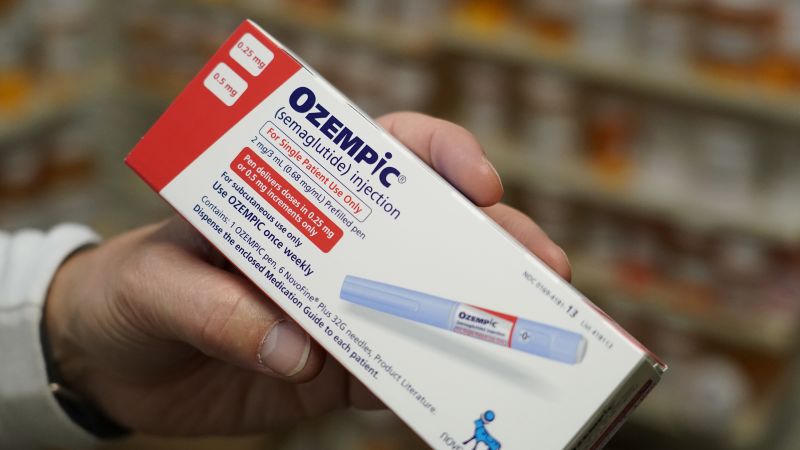The US economy is set to reap considerable benefits from Americans taking popular medications used for weight loss, including Ozempic and Wegovy, Goldman Sachs analysts wrote in a recent research report.
Those drugs are part of a powerful new class of medications that has taken the world by storm, known as glucagon-like peptide 1 or GLP-1 receptor agonists. Originally developed to treat type 2 diabetes, they proved to be highly effective at helping people shed weight in clinical trials. (Ozempic has not been approved for weight loss by regulators, though Wegovy, a similar drug, has.)
Goldman Sachs argues that since poor health unambiguously weighs on the economy, improving health outcomes due to GLP-1s could lower costs and boost productivity, shoring up economic output.
The Wall Street bank estimates that GLP-1s could add 0.4% to America’s gross domestic product, a broad measure of all the goods and services produced in the economy, “in a baseline scenario where 30 million users take the drugs and 70% experience benefits,” and as much as 1% if 60 million Americans take those drugs regularly.
The US economy overall was about $28 trillion in the fourth quarter, so if Goldman’s bullish case bears out, that means GLP-1 drugs alone could boost output by a trillion dollars over the next four years, more or less.
That would be a sizable boost to the economy, but the true extent of the impact also depends on the scale of production and compliance with treatment plans, according to the report, which also examined the potential effects of drug discovery powered by artificial intelligence and advances in gene editing.
“We view the current wave of healthcare innovation as a promising macro (in addition to human and micro) story with the potential to drive meaningful economic upside across a range of likely scenarios.” analysts wrote.
Poor health has clear, negative impacts on Americans in the job market, such as keeping some workers on the sidelines and reducing the number of hours worked, according to longstanding research.
Based on a combination of “current losses in hours worked and labor force participation from sickness and disability, early deaths, and informal caregiving,” poor health drags on US economic output down by about 10% per year, Goldman Sachs analysts estimated.
Obesity and related complications contribute to constraints on labor supply in the United States. Government statistics show that more than a third of Americans are overweight and more than 42% have obesity. Another survey shows that nearly half of US adults said they have tried to lose weight over the past year.
The Goldman Sachs report noted that “academic studies find that obese individuals are both less likely to work and less productive when they do.”
“These estimates suggest significant upside to economic output if the recent wave of healthcare innovation leads to an improvement in health outcomes that reduces the economic burden of poor health,” analysts wrote.
GLP-1s have become so popular that pharmaceutical companies have been forced to beef up supply in attempts to keep up with red-hot demand. Novo Nordisk and Eli Lilly, which has its own GLP-1 drug for diabetes, Mounjaro, have invested billions of dollars to expand capacity.
For some Americans who are obese but don’t have diabetes, obtaining those drugs has become difficult, if not impossible. That’s according to Jody Dushay, an attending endocrinologist at the Beth Israel Deaconess Medical Center, in a recent opinion piece for CNN.
Novo Nordisk, which manufactures Wegovy, said recently that it has started to increase the availability of the drug for Americans “by more than doubling the amount of the lower-dose strengths of Wegovy compared to the previous months,” Doug Langa, the company’s head of North America operations, said on a call with analysts earlier this month.
The drugs are also known for being expensive, and they’ve recently gotten even pricier. Novo Nordisk raised the list price of Ozempic by 3.5% to $969 for a four-week supply in January, while Eli Lilly last month increased the price of Mounjaro by 4.5% to $1,069 for a four-week supply, according to 46brooklyn, a nonprofit drug pricing analytics firm. The final price Americans pay for medications depends on their health insurance policies, not drugmakers’ list prices.
Read the full article here




